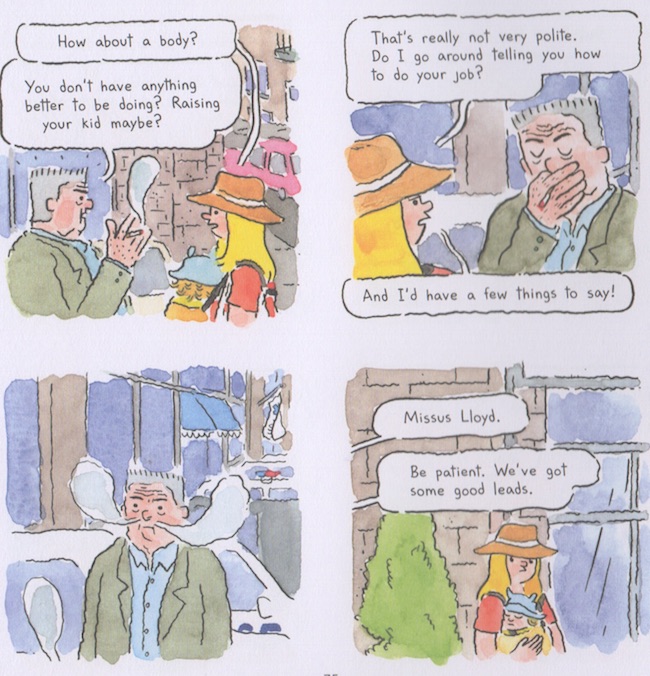This is a breezy romp, coming in at under a hundred pages, and featuring attractive, accessible cartooning. Each page features a grid of six unbordered panels, and squiggles of lines that are tighter than a doodle but perfectly clear in their minimalism. There’s a slight shakiness to the line that finds a nice complement in the bright painted watercolors, which foreground the protagonist’s blonde hair in a primary yellow against gentler backgrounds. That character, the Rebecca of the book’s title, is the mother to a small child - and beyond situational recognizability, what may endear this comic to mothers of young children is that it reads easily enough to be a soothing balm to a harried mind. It’s perfect for someone who wants to read a comic, but not one that’s long, or depressing, or challenging in any way. You can read it while doing something else: I was only nursing a mild headache, but others have lives that force them to be more ambitious.
Pascal Girard has made enough autobiographical comics that I will take as a given what are in actuality only presumptions: since his last book, he had a child named Lucie with his partner, Rebecca, whom this book is dedicated to, and who is credited as the cowriter of a sequence that details her giving birth. The bulk of the book, given over to an adventure mother and child get into, is created from the author’s imagination. Despite the genre machinations of amateur detective investigations, the core of the book is rooted in autobio, so that it feels like it’s meant to appeal to mothers of small children who will recognize bits where a physical therapist asks Rebecca if she’s been doing her kegels. Even the hijinx of Rebecca running around with Lucie in tow seem to aim less for the satisfaction that comes from watching a well-constructed mystery come together, than to further the low-key comedy of social embarrassment. In one sequence, Rebecca, having stolen her husband’s ID, sneaks around him at his place of employment; this is presented as suspenseful, but there’s basically no stakes at all. There’s danger at the story’s climax, but it’s dispatched quickly. Through it all, Girard demonstrates an eye for body language, clearly showing his characters navigating through different locations.

What unites the mystery and the childrearing is a subtext so soft-pedaled I may be imagining it: the affection a mother feels for her infant daughter, contrasted against the antipathy a grown adult might feel towards their aging parents. It’s an in-home caregiver whose disappearance sets the plot in motion, and the chief suspects are the children of the elderly person being cared for, upset that the person who spends time caring for their parents might end up cut into the will. At the end of the story, when Rebecca brings up visiting Pascal’s parents in order to follow up on this lead, the rationale of the importance of having a child know their grandparents is presented dutifully - yet these parents are never shown, and their importance to the narrative of Rebecca and Lucie is nil.
While Girard’s previous autobio comics for Drawn and Quarterly were in black and white, this is his second book in full color, following up Fanny & Romeo, a book written by Yves Pelletier and published by Conundrum Press. The visual style recalls Max de Radigués, while the approach to coloring is comparable to Leslie Stein’s recent work. I kept thinking of Lewis Trondheim, another cartoonist known both for autobio strips and genre exercises that remain rooted in humor. The cover design is reminiscent of the books Lucy Knisley did for Fantagraphics. There’s a small running joke here where characters are told they look like other characters in the book, possibly emerging out of the cartoonist’s self-consciousness about his character designs’ self-similarity. The character of “Pascal Girard” in the book himself looks pretty similar to the self-caricature of Mike Dawson that appears in Dawson's diary comics created for social media. It’s a comic among many others that speaks a common language arrived at when one knows what they’re doing and aims for accessibility. It’s easy to overlook this work, but its virtues are real. Prose has its beach reads, which achieve their readability through suspense and reader investment in the plot, and comics has these works that achieve similar buoyancy through lively drawing that captures the gestures of everyday life.








